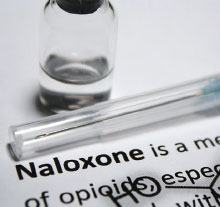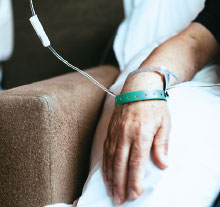Journal Digest: Naloxone Access; Tic Suppression; Anorexia; Pre-Chemo Depression; Work Culture; Social Inclusion
Co-Prescription Laws Significantly Increase Naloxone Access

Recent state laws that have mandated naloxone co-prescriptions to at-risk patients receiving opioids (such as those with a history of overdose) are effective at increasing naloxone prescription dispensing, according to an analysis in JAMA Network Open. Virginia and Vermont—the first two states to implement naloxone co-prescribing laws—saw a nearly eightfold increase in naloxone dispensing compared with states without such laws.
A team at the University of Kentucky and Ferris State University compared monthly naloxone-prescribing trends in Virginia and Vermont with other states and the District of Columbia for the 2017 calendar year.
In the first full month after the mandate went into effect, 88 prescriptions per 100,000 people were dispensed in Virginia (April 2017) and 111 prescriptions per 100,000 people were dispensed in Vermont (July 2017). In comparison, only 16 naloxone prescriptions per 100,000 people were dispensed in July 2017 among the nine states (and District of Columbia) with the highest rates of opioid overdose deaths, and only six prescriptions per 100,000 were dispensed in the 39 remaining states.
By December 2017, the naloxone-dispensing rate dropped in both Vermont and Virginia (to 25 and 34 prescriptions per 100,000, respectively), but it still outpaced the remaining states. The authors noted, “This trend is anticipated to some extent, as the legal mandates for naloxone co-prescription are at the patient level and not the prescription level.”
Sohn M, Talbert JC, Huang Z, et al. Association of Naloxone Coprescription Laws With Naloxone Prescription Dispensing in the United States. JAMA Netw Open. 2019;2(6): e196215
Tic Suppression for Reward Predicts Future Tic Severity

Findings from a longitudinal study by researchers at Washington University School of Medicine in St. Louis and Johns Hopkins University may help predict which children with recent-onset tics will go on to develop Tourette’s syndrome or a chronic tic disorder. The findings were published in The Journal of Child Neurology.
The researchers assessed 45 children (30 boys) with recent-onset tics to confirm date of tic onset as well as tic severity and other behavioral symptoms. The children were also asked to perform a set of tic suppression tasks under three different conditions: tic as needed, suppress tics on verbal instruction, and suppress tics for a reward. The children then returned for a follow-up visit at the one-year anniversary of their tic-onset date.
The researchers found that children who suppressed tics for a reward had lower tic burden at the 1-year anniversary of tic onset than those who could not suppress tics. The ability to suppress tics in the absence of a reward did not predict future tic severity.
The authors concluded, “Our study shows that despite … possible impairment in inhibitory function, children could suppress tics without years of tic suppression practice. … [I]f better tic suppression at the baseline visit is due to better overall inhibitory control, this lessened impairment may explain why these children have better tic outcomes later, perhaps because of better management of tics.
Kim S, Greene DJ, Robichaux-Viehoever A, et al. Tic Suppression in Children With Recent-Onset Tics Predicts 1-Year Tic Outcome. J Child Neurol. June 26, 2019. [Epub ahead of print]
Low-Dose Testosterone Fails to Benefit Women With Anorexia

Low-dose testosterone therapy did not improve depressive behaviors or eating problems in women with anorexia nervosa, reported a study published in The Journal of Clinical Endocrinology & Metabolism.
Previous research in both men and women has suggested that low testosterone is associated with elevated depression and anxiety, both of which contribute to more severe anorexia symptoms.
Researchers from Massachusetts General Hospital, Harvard Medical School, and other Boston-area institutions randomized 90 adult women with anorexia and lower-than-average testosterone to receive a testosterone patch (300 mcg) or a placebo patch applied twice weekly for 24 weeks.
At the end of the study, there were no differences between the two groups of women in terms of eating behaviors, including dietary restraint or eating concerns, or depression and anxiety severity (as assessed by the Hamilton Rating Scales for depression and anxiety, respectively).
The only significant difference was that women in the placebo group gained more weight (around a 1-point increase in body mass index [BMI]) than the testosterone group did (no net BMI change).
Kimball A, Schorr M, Meenaghan E, et al. A Randomized, Placebo-Controlled Trial of Low-Dose Testosterone Therapy in Women With Anorexia Nervosa. J Clin Endocrinol Metab. June 20, 2019. [Epub ahead of print]
Pre-Chemo Depression Reduces Survival Odds From Blood Cancer

Patients with a blood cancer who have depression before starting chemotherapy have shorter survival than those without depression, according to a study published in Psycho-Oncology.
The risk of shorter survival remains even if the patient experiences remission of depression after starting chemotherapy, according to the study authors from the Nagoya City University Hospital in Japan and colleagues. They said that the findings support providing better depression care at the time of cancer diagnosis.
The study included 255 patients who initiated chemotherapy for lymphoma or multiple myeloma between 2010 and 2016. As part of the study, the participants completed the Patient Health Questionnaire-9 (PHQ-9) upon enrollment and again one month later.
Eighty-three of the participants met criteria for depression during the study: 38 reported depressive symptoms at baseline only, 19 reported depressive symptoms at the one-month follow-up, and 26 reported depressive symptoms at both time points.
All participants were followed until death or the study cutoff date of March 2018. During this time 61 patients died: 31 patients who had depression at some point during the follow-up, and 30 patients with no depression.
A survival analysis indicated that compared with patients with no depression, those who had depression at the onset of the study were about two to three times more likely to die during the roughly four-year follow-up period, whether the depression later went into remission or not. There was no significantly elevated risk of death among patients who developed depression after chemotherapy began.
Hasegawa T, Okuyama T, Uchida M, et al. Depressive Symptoms During the First Month of Chemotherapy and Survival in Patients With Hematological Malignancies: A Prospective Cohort Study. Psycho-Oncology. July 2, 2019. [Epub ahead of print]
Work Culture Predicts Adoption of New Practices

Though change can be slow, system-wide efforts to implement evidence-based practices do lead to modest changes in physician behavior, according to a multi-year study conducted by researchers at the University of Pennsylvania Perelman School of Medicine.
The researchers surveyed physicians at 20 behavioral health outpatient clinics for youth in the Philadelphia region; data were collected at three different times between 2013 and 2017. Also occurring during this time, Philadelphia’s Department of Behavioral Health and Intellectual Disability Services was implementing a citywide initiative to facilitate greater use of cognitive-behavioral therapy (CBT) techniques rather than psychodynamic techniques for youth with psychiatric disorders.
The respondents listed their frequency of use of either CBT or psychodynamic techniques with patients on a five-point scale ranging from 1, rarely used, to 5, most of the time.
uring the study period, the use of CBT techniques increased by about 6% among all the clinics (going from an average score of 3.18 to 3.37), while psychodynamic techniques remained constant (3.37 to 3.41).
The researchers found the greatest changes at health centers that had a proficient organizational culture, where there are “shared norms and expectations” that staff puts patients first and have up-to-date knowledge. At proficient centers, CBT techniques increased 8%, while psychodynamic techniques decreased by 2%. Having a proficient culture had a stronger effect on change than either having engaged leadership or strong resources to help implement new ideas. The study was published in Implementation Science.
Beidas RS, Williams NJ, Becker-Haimes EM, et al. A Repeated Cross-Sectional Study of Clinicians’ Use of Psychotherapy Techniques During 5 Years of a System-Wide Effort to Implement Evidence-Based Practices in Philadelphia. Implement Sci. 2019; 14(1): 67
Researchers Develop Psychiatric Assessment for Social Inclusion

People with mental illness are at higher risk of social exclusion, which in turn increases their risk of poor health outcomes. Researchers at the University of Melbourne have now developed an assessment tool to measure a patient’s sense of feeling included or excluded, which can help identify appropriate interventions and monitor patient progress. A description and preliminary test of the tool, called the Filia Social Inclusion Measure (F-SIM), is presented in Psychiatry Research.
The F-SIM includes 55 questions divided across five domains: housing and services, relationships and activities, employment/education, finances, and overall well-being. The researchers tested F-SIM on 90 participants, including 30 people with a psychiatric illness, 30 family members or caregivers of someone with a psychiatric illness, and 30 controls with no personal or family psychiatric illness.
The results showed that both patients and caregivers reported lower scores in all five social inclusion domains compared with the control participants, with caregivers falling in between patients and controls. The researchers said that this suggests the test has good discrimination ability.
Most participants also rated the F-SIM as easy to use and not too long (average completion time was 16 minutes). “There are some logical next steps in the F-SIM’s development, including shortening and psychometrically evaluating the shortened version,” the authors wrote. “Despite participants reporting the F-SIM as not being terribly burdensome to complete, measures are rarely completed in isolation and not as part of a greater assessment package.” ■
Filia KM, Jackson HJ, Cotton SM, Killackey EJ. Developing and Testing the F-SIM, a Measure of Social Inclusion for People With Mental Illness. Psychiatry Res. 2019; 279: 1-8



